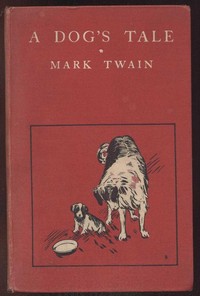A Dog's Tale by Mark Twain
"A Dog's Tale" by Mark Twain is a short story written in 1903. Told from the perspective of a mixed-breed dog, the narrative follows her devotion to her human family through moments of heroism and heartbreak. After saving a child from a nursery fire, she suffers a cruel misunderstanding. Later, tragedy strikes when her own puppy becomes the victim of a scientific experiment, leading to a haunting conclusion about loyalty, sacrifice, and
the innocent suffering of animals. (This is an automatically generated summary.)
Read or download for free
| How to read | Url | Size | |||
|---|---|---|---|---|---|
| Read now! | https://www.gutenberg.org/ebooks/3174.html.images | 52 kB | |||
| EPUB3 (E-readers incl. Send-to-Kindle) | https://www.gutenberg.org/ebooks/3174.epub3.images | 323 kB | |||
| EPUB (older E-readers) | https://www.gutenberg.org/ebooks/3174.epub.images | 322 kB | |||
| EPUB (no images, older E-readers) | https://www.gutenberg.org/ebooks/3174.epub.noimages | 60 kB | |||
| Kindle | https://www.gutenberg.org/ebooks/3174.kf8.images | 354 kB | |||
| older Kindles | https://www.gutenberg.org/ebooks/3174.kindle.images | 344 kB | |||
| Plain Text UTF-8 | https://www.gutenberg.org/ebooks/3174.txt.utf-8 | 42 kB | |||
| Download HTML (zip) | https://www.gutenberg.org/cache/epub/3174/pg3174-h.zip | 318 kB | |||
| There may be more files related to this item. | |||||
Similar Books
About this eBook
| Author | Twain, Mark, 1835-1910 |
|---|---|
| Title | A Dog's Tale |
| Note | Wikipedia page about this book: en.wikipedia.org/wiki/A_Dog%27s_Tale |
| Credits | Produced by David Widger |
| Reading Level | Reading ease score: 69.3 (8th & 9th grade). Neither easy nor difficult to read. |
| Language | English |
| LoC Class | PS: Language and Literatures: American and Canadian literature |
| Subject | Dogs -- Fiction |
| Category | Text |
| EBook-No. | 3174 |
| Release Date | Jun 1, 2004 |
| Most Recently Updated | Jan 27, 2021 |
| Copyright Status | Public domain in the USA. |
| Downloads | 1470 downloads in the last 30 days. |
| Project Gutenberg eBooks are always free! | |

